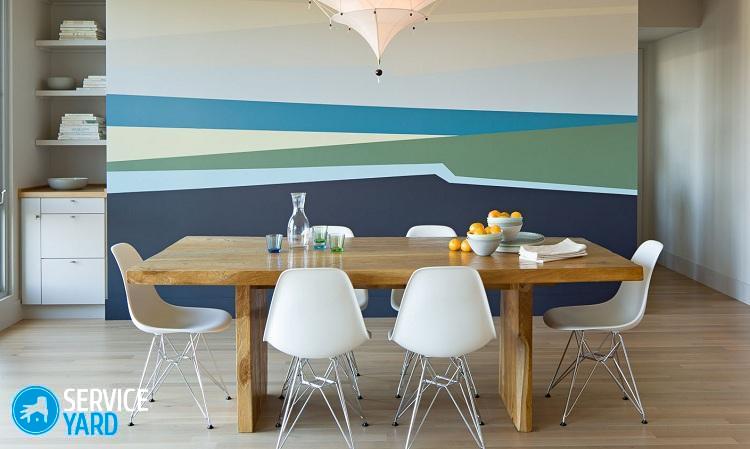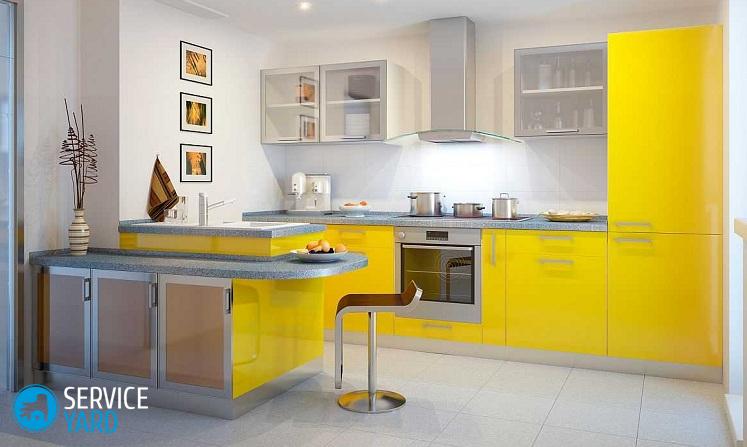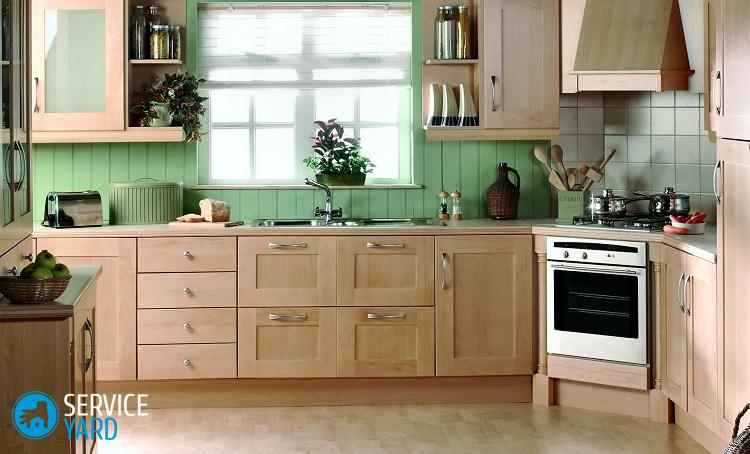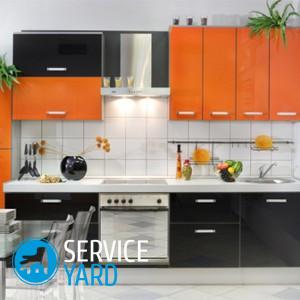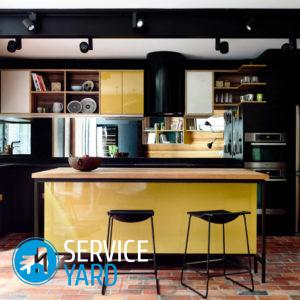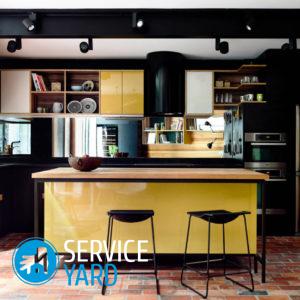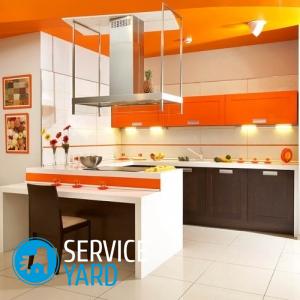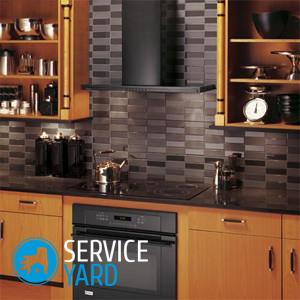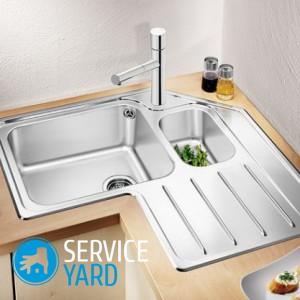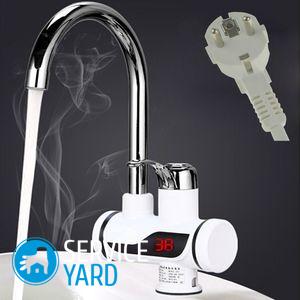Painting the walls in the kitchen
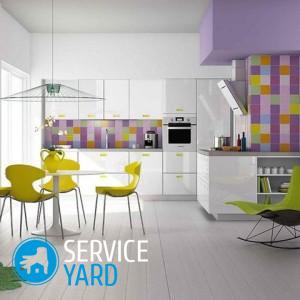
When making repairs in the kitchen, it is very important to choose the right interior decoration of the walls, because this is a room with rather high hygiene requirements. During operation, dust and condensation settle on the walls, grease gets in and scratches appear. Therefore, many modern interior designers believe that the best solution is to paint the walls in the kitchen. Surfaces coated with this decor are easy to maintain and can be updated without much difficulty. This is the perfect solution to help you create a stylish and affordable design while maintaining perfect cleanliness.
to contents ↑Why painting?
If you still can’t decide on the choice of material for interior decoration of surfaces in the kitchen, we offer you the main advantages of painting walls:
- Unlimited selection of different colors. You can choose exactly the color that fits perfectly into the interior of the kitchen or by mixing to get the tone you need.
- Low price. In relation to the wallpaper or the tile so popular, this is a rather cheap decorative coating. Nevertheless, in its aesthetic characteristics, the paint is in no way inferior to the more expensive "relatives".
Important! Today, a fairly popular solution in the design of the kitchen interior is to completely paint the walls using tiles only on a small part of the wall - the kitchen apron.
- High technical specifications. Due to the fact that paints have properties such as moisture resistance, the ability to preserve color and resistance to stains, they are ideal for decorating walls in the kitchen.
to contents ↑Important! Since you have decided to paint the kitchen, then first of all it is worth deciding what to paint. Indeed, among the variety of materials on the shelves of construction stores it is difficult to find something that will meet all the requirements and not fatally hit the wallet. Our article will help you make a difficult choice. “Washable kitchen paint”.
Types of paints
To date, the following types of paints that are used for interior wall decoration are presented on the modern building materials market:
- Water emulsion;
- Alkyd;
- Silicone
Next, we consider each of them in more detail.
Water emulsion or water dispersion
Decorative wall decoration with water based paint is the most commonly used option, especially for decorating a kitchen in a modern style. Thanks to it, you can achieve a perfectly flat and smooth surface, which acquires a beautiful gradient with proper lighting.
In addition, water based paints have a number of advantages:
- Water resistance, which is important in the kitchen;
- The ability to color with any color, respectively - a large range of diverse color schemes;
Important! Since the paint, due to the palette, gives a wide scope for imagination, it is difficult to finally determine the color scheme. Therefore, we have selected for you several flocks that will slightly facilitate this task:
- High environmental friendliness;
- Ease of application;
- Lack of an unpleasant smell;
- Vapor permeability;
- It is easily washed off from hands and tools;
- High adhesive properties (ability to stay for a long time on the surface of the walls without peeling and cracks);
- Durability;
- Quick drying;
- Fire safety;
- No need to purchase solvents and other harmful chemicals used for these purposes;
- Hypoallergenicity;
- Budgeting.
The main disadvantage of such paints is that at low temperatures they completely lose all their characteristics. Therefore, this coating is best stored at room temperature.
Important! If you doubt the quality of the paint, before you paint the walls in the kitchen, you can quickly and easily check it. For this:
- Apply paint to the sample and place in a bowl of water for a day.
- Another option is to apply it to the finger, and then place it under a stream of cold water for 10-15 minutes.
If the paint is of high quality, then nothing should happen to it. Otherwise - it becomes covered with bubbles and begins to peel off.
Water-based paints come in two forms:
- Acrylic They form the basis of all water-based paints, are quite universal in work and are presented in a huge assortment.
- Latex. Such paints are more durable and have high performance. Unfortunately, latex formulations have a lower vapor permeability, therefore, they have the ability to “accumulate” moisture.
Alkyd paints
This is a less popular material, however, widely used for interior wall painting. The main advantages of this coloring composition include:
- High rate of wear resistance, strength and elasticity;
- Able to withstand various changes in temperature and humidity;
- Saturated bright and rich colors.
The disadvantages of this paint include:
- Persistent pungent odor;
- Fire hazard;
- The restriction in the choice of tones, because unlike water-based tones, they are sold ready-made, a certain color.
Like water emulsion, alkyd compounds are of two types:
- Pentaphthalic. They can be recognized by marking PF on the surface of the banks.
- Gliftal. Their marking is GF.
Important! Please note that, in addition to lettering, a number is also placed on the packaging indicating the enamel category.
Silicone
These are pretty “young” coloring compounds that are gaining high popularity at a fast pace. They received such demand due to:
- Good water resistance;
- High resistance to coating, ultraviolet and burnout;
- Good alkali resistance, therefore, the silicone compound can be applied to the surface of the wall a couple of days after it was plastered;
- Not aggressiveness;
- The absence of an unpleasant and pungent odor;
- The ability to choose any color and achieve the desired tone.
The only drawback of silicone paints is their high cost.
to contents ↑Important! To date, manufacturers have begun to produce a cheap analogue of silicone compounds - silicone paint. This is a mixture of silicone and acrylic base. The quality of this material is significantly “lame” in relation to silicone.
Options to consider when choosing a paint
When purchasing a certain painting composition for painting walls in the kitchen, it is very important to consider the following recommendations:
- Price. Never focus on very cheap options, as the lower the price range, the worse the quality of the composition.
- Type of coverage. You need to decide in advance what your walls will be and how they should shine.
Important! Pay your attention to the fact that glossy paints will emphasize all the irregularities of the wall surface, and every spot will be visible on matte ones. Therefore, for the kitchen, silky-glossy compositions will be an ideal option.
- When choosing such a material, always take into account the fact that the actual color may slightly differ from that indicated in the catalog or on the package.
Important! If you have difficulty choosing between two identical shades, you should ask the seller to dilute 1 liter of each composition in separate containers (this is a paid option). Paint a piece of paper or sheets of paper and compare the finished result.
- You can safely acquire silicone and acrylic paints without fear, since they are always in stock. Even if something is not enough for you, you can easily get the missing color in the store, and by coloring you can achieve the desired shade. As for alkyd compounds, it is better to purchase them immediately with a small margin.
to contents ↑Important! If you have doubts about the amount of finishing material needed, you should contact a sales consultant who will help you make the right calculations or use a special calculator.
Necessary tools
Before you paint the walls in the kitchen, you still need to purchase tools specifically designed for this purpose. You will need:
- Rollers. For painting walls, it is best to use a width of 20-30 centimeters and a pile length of 8-12 millimeters. Also, when choosing, one should take into account the fact that the smaller the pile, the smoother the surface will be.
Important! Try to avoid foam and velor rollers. They are not functional and they cause difficulties when painting.
- Radiator roller. It is necessary for painting hard-to-reach spots.
- Brushes. They are best used for painting small areas, as well as butt areas. Try to choose models with a width of 35 or 50 millimeters.
Important! Pay attention to the fact that for working with alkyd compositions it is best to choose brushes with natural pile, and for water emulsions - with synthetic.
- Capacity and tray for paint.
Painting the kitchen - step by step instructions
The whole cycle of work when painting the walls in the kitchen will be phased, so think in advance of the period in which you can safely perform the work without problems.
Padding
For starters, it is very important to priming the surface. This will help you:
- Improve the adhesive properties of the paint;
- Significantly increase the operational life of your chosen coating;
- Create guaranteed protection against excessive moisture absorption;
- Get a uniform and even application of paint.
Important! It also contributes to a more economical consumption of material.
In order to primer the walls in the kitchen before painting, you need to adhere to the following procedure:
- Remove any bumps or small debris that has stuck to the surface of the wall during puttying using a large spatula.
- Pour the primer into the tray, soak the roller well in it, then wring it out.
- Start applying this mixture to the wall surface from top to bottom, moving from one edge of the wall to the other.
Important! The primer itself is quite liquid, so it tends to leave stains. When they appear, try to remove immediately with a roller, without waiting for drying.
- Using a wide brush, ground hard-to-reach places and joints.
- Leave the walls for 5-6 hours until the primer dries completely.
Preparatory work before painting
Before you start the direct process of painting walls in the kitchen, you need to:
- Make sure that the primer on the walls is completely absorbed and dried;
- Check primed surfaces for small debris, in which case - remove it;
- Cover the doors, floor, and all furniture with plastic wrap;
- Take care of good lighting in case the painting is carried out in the evening;
- Prepare all the necessary tools for work;
- Dilute the paint in the proportion you need.
Important! In order to prevent lint from brushes or rollers on the wall during painting, rinse them in warm water and dry them to a damp state before starting work.
Getting started painting
The basic rule of such decorative wall decoration is painting the largest possible area, or better, immediately the entire wall in one go. If you have already begun work, then categorically it is impossible to interrupt it, even for a couple of hours. Therefore, in advance, calculate your strength and time.
Important! Pay attention to the fact that the paint must be applied in two layers. For the first, it needs to be diluted quite a bit to get a 10-15% composition, and for the second, it is strictly guided by the manufacturer's recommendations indicated on the package and mix well.
We proceed to work, observing the following procedure:
- It is best to start from the window. Outline a section 1-2.5 meters wide.
- If you use a roller, then pour paint into the pallet, if the brushes - in a special container.
- Using a brush, paint over the edges of your chosen area.
Important! If you start painting from a corner, then it also needs to be painted.
- Blot well in the paint composition and roll it on the ribbed surface on the pallet. This way you remove excess paint.
Further, the technique of working with a roller directly depends on which paint you have chosen. Aqueous emulsion is best applied as follows:
- Over the entire area of your choice, make several W-shaped movements.
- Spread the paint evenly and tightly, making smooth up and down movements.
Important! In order to paint the walls with fewer stains, you can use the cellular technique. To do this, first paint on the surface of your choice exclusively with up and down movements, and the second layer with horizontal ones.
Alkyd in application are complex, respectively - the process is longer. The sequence of actions is as follows:
- Using a brush, apply the first coat using the retouching method (quick brush strokes from side to side).
- The second layer must be applied with a W-shaped or cellular method.
to contents ↑Important! Before applying the second coat, make sure that the first is completely dry.
Create drawings on the wall
In order to make the kitchen design even more original, we suggest that you decorate it with elements of art painting. To do this, you do not need to have a talent for drawing or to call an artist.
Important! If you don’t have a special talent for drawing, and you don’t have money for a good artist, try to pick up ready-made ones pictures for the kitchen.
If you still decide to create such a picture, then prepare for the fact that this process is quite lengthy and painstaking. To do this, you need to apply a drawing with a pencil on the wall, and after that - paint with water-based paints.
Important! To create a more voluminous visualization, you can decorate your drawing with stones or using decorative plaster.
At the end of the finished drawing, tint with acrylic and cover with a protective layer of varnish.
to contents ↑Important! If there are sockets on the wall where you plan to paint, you can decorate them to match the overall picture.
Wall Painting Tricks
In order for the process of painting walls in the kitchen to proceed quickly, and the finished coating to be flawless, we bring to your attention several recommendations:
- If you are a beginner in the painting business, then first select the area that will be covered with furniture in the future;
Important! By the way, the choice of kitchen appliances and furniture is another difficult issue for those who begin repairs. Therefore, as soon as you decide on the color of the walls, start choosing everything else and how to do it easily read on our blogs:
- In order for the layer to be uniform, the force on the roller should be medium;
- Masking tape must be removed immediately after painting, without waiting for the walls to dry completely;
- In order for the roller tray to last longer, you can wrap it with food foil before starting work;
- First, in a small container, make a trial coloring, after reaching the color you need, you can safely dilute the entire jar;
- Even with good daylight, try to use additional sources - so you can fully evaluate the result and see poorly stained areas.
to contents ↑Important! When you more or less figured out the decoration and furniture, it’s time to take the plumbing and, unfortunately, the choice is not easier, but it means you should seriously study the question:
Stock footage
As you can see, painting walls in the kitchen is a very easy and entertaining process. The most important thing is to adhere to the above tips of our specialists. So you can independently produce decorative wall decoration that fits perfectly into the overall interior of the room, and your kitchen will “sparkle” with new colors.
- How to choose the color of the kitchen?
- What color to paint the walls in the kitchen?
- How to choose the color of countertops for the kitchen?
- Washable kitchen paint
- How to choose a kitchen faucet?
- Pictures for the kitchen on the wall
- How to calculate the power of the hood for the kitchen?
- Built-in appliances for the kitchen - how to choose which company?
- Rating sinks for the kitchen
- Kitchen water heater



